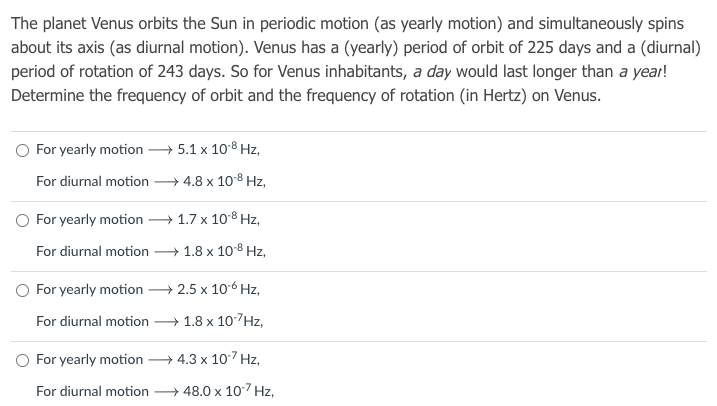The planet Venus orbits the Sun in periodic motion (as yearly motion) and simultaneously spins about its axis (as diurnal motion). Venus has a (yearly) period of orbit of 225 days and a (diurnal) period of rotation of 243 days. So for Venus inhabitants, a day would last longer than a year! Determine the frequency of orbit and the frequency of rotation (in Hertz) on Venus. For yearly motion → 5.1 x 108 Hz, For diurnal motion → 4.8 x 108 Hz, O For yearly motion → 1.7 x 108 Hz, For diurnal motion 1.8 x 108 Hz, For yearly motion → 2.5 x 106 Hz, For diurnal motion → 1.8 x 107HZ, For yearly motion → 4.3 x 107 Hz, For diurnal motion → 48.0 x 107 Hz,
The planet Venus orbits the Sun in periodic motion (as yearly motion) and simultaneously spins about its axis (as diurnal motion). Venus has a (yearly) period of orbit of 225 days and a (diurnal) period of rotation of 243 days. So for Venus inhabitants, a day would last longer than a year! Determine the frequency of orbit and the frequency of rotation (in Hertz) on Venus. For yearly motion → 5.1 x 108 Hz, For diurnal motion → 4.8 x 108 Hz, O For yearly motion → 1.7 x 108 Hz, For diurnal motion 1.8 x 108 Hz, For yearly motion → 2.5 x 106 Hz, For diurnal motion → 1.8 x 107HZ, For yearly motion → 4.3 x 107 Hz, For diurnal motion → 48.0 x 107 Hz,
University Physics Volume 1
18th Edition
ISBN:9781938168277
Author:William Moebs, Samuel J. Ling, Jeff Sanny
Publisher:William Moebs, Samuel J. Ling, Jeff Sanny
Chapter15: Oscillations
Section: Chapter Questions
Problem 27P: Each piston of an engine makes a sharp sound every other revolution of the engine. (a) How fast is a...
Related questions
Question

Transcribed Image Text:The planet Venus orbits the Sun in periodic motion (as yearly motion) and simultaneously spins
about its axis (as diurnal motion). Venus has a (yearly) period of orbit of 225 days and a (diurnal)
period of rotation of 243 days. So for Venus inhabitants, a day would last longer than a year!
Determine the frequency of orbit and the frequency of rotation (in Hertz) on Venus.
O For yearly motion 5.1 x 108 Hz,
For diurnal motion
— 4.8 х 108 Hz,
O For yearly motion
+ 1.7 x 108 Hz,
For diurnal motion 1.8 x 10-8 Hz,
O For yearly motion → 2.5 x 106 Hz,
For diurnal motion
+ 1.8 х 107Hz,
O For yearly motion
→ 4.3 x 107 Hz,
For diurnal motion
→ 48.0 x 10-7 Hz,
Expert Solution
This question has been solved!
Explore an expertly crafted, step-by-step solution for a thorough understanding of key concepts.
This is a popular solution!
Trending now
This is a popular solution!
Step by step
Solved in 4 steps with 4 images

Knowledge Booster
Learn more about
Need a deep-dive on the concept behind this application? Look no further. Learn more about this topic, physics and related others by exploring similar questions and additional content below.Recommended textbooks for you

University Physics Volume 1
Physics
ISBN:
9781938168277
Author:
William Moebs, Samuel J. Ling, Jeff Sanny
Publisher:
OpenStax - Rice University

An Introduction to Physical Science
Physics
ISBN:
9781305079137
Author:
James Shipman, Jerry D. Wilson, Charles A. Higgins, Omar Torres
Publisher:
Cengage Learning

College Physics
Physics
ISBN:
9781285737027
Author:
Raymond A. Serway, Chris Vuille
Publisher:
Cengage Learning

University Physics Volume 1
Physics
ISBN:
9781938168277
Author:
William Moebs, Samuel J. Ling, Jeff Sanny
Publisher:
OpenStax - Rice University

An Introduction to Physical Science
Physics
ISBN:
9781305079137
Author:
James Shipman, Jerry D. Wilson, Charles A. Higgins, Omar Torres
Publisher:
Cengage Learning

College Physics
Physics
ISBN:
9781285737027
Author:
Raymond A. Serway, Chris Vuille
Publisher:
Cengage Learning

University Physics Volume 3
Physics
ISBN:
9781938168185
Author:
William Moebs, Jeff Sanny
Publisher:
OpenStax

Physics for Scientists and Engineers: Foundations…
Physics
ISBN:
9781133939146
Author:
Katz, Debora M.
Publisher:
Cengage Learning

Principles of Physics: A Calculus-Based Text
Physics
ISBN:
9781133104261
Author:
Raymond A. Serway, John W. Jewett
Publisher:
Cengage Learning